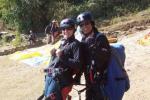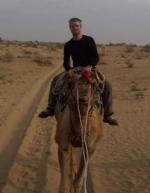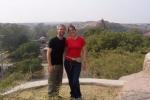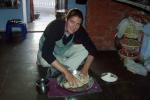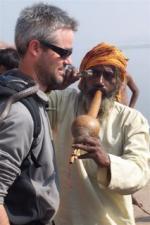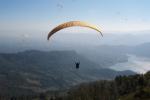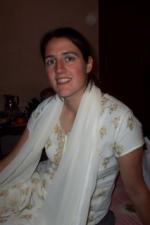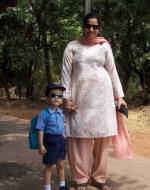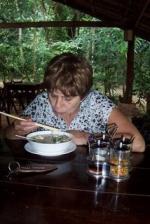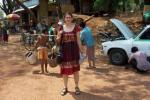|
Nepal is home to eight of the ten highest mountains in the world. Of these, we only managed to see two of them during our trek through the Annapurna Circuit: Daulagiri (Number seven at a height of 8167 meters), and Annapurna I (Number ten at a height of 8091 meters). While we won't have time to trek up to the other mountains until our next visit, there are alternatives.
Nepal offers perhaps the most scenic mountain flights in the world. Unfortunately, Kathmandu's dubious airport is strategically located in a part of the valley nearly always covered in a thick blanket of early morning fog. It took me three trips to the airport before there was barely enough visibility to allow planes to take off. However, once you do manage to catch a plane, it will get you your shot of nearly all the great Himalayan peaks with almost no physical effort. It isn't quite the same as walking up there- the sterile cabin environment just can't reproduce the experience of actually earning the view. On the other hand, this is the only way you can enjoy gazing upon the world's highest point with a gin and tonic in your hand.

Mount Everest. Elevation 8848 meters. Highest point on earth.
A couple of weeks ago, in an over-priced Indian budget hotel room in Jaipur, something attracted my attention: barely visible through the snowy static of the television screen was a a picture of Sir Edmund Hillary: most likely the first person, together with Nepali Sherpa Tenzing Norgay, to reach the peak of Mount Everest in 1953. Edmund Hillary had just died. The only photograph taken on Everst's peak commemorating the successful joint Nepali-Indian-British expedition, is of Tenzing taken by Hillary. It has become a very famous image since appearing on Nepal's own "Everest" beer label.
Interestingly, in 1999, they found the body of George Mallory and his partner frozen just beneath the summit fueling speculation that they had reached the summit many years earlier in a 1924 expedition. It is still not clear whether they froze to death on the way up or on the way down. While, Tenzing and Hillary are still credited with the first successful Everest conquest, George Mallory is more famous for his stoic reply to a journalist questioning the purpose of climbing Everest: "because it's there".
These days, you need to meet three necessary requirements to conquer Everest: you must be an experienced mountaineer, totally nuts, and filthy rich (not necessarily in that order). It costs 60,000 Euros just to be given permission to climb Everest. Nevertheless, though many die each year "because it's there", wealthy people continue to pay the exorbitant fee for their chance. In Nepal, you can hear many of their stories. Some of these stories are gripping, such as the definitive adventure book written about the tragic 1996 expedition, Into Thin Air by Jon Krakauer (also a film). However, my favorite story is that of Briton Maurice Wilson, who enacted his cunning plan to crash a private plane halfway up the mountain and then simply walk from there to the top. He was found frozen to death in a light sweater a few hundred meters from the crash sight, proving that harboring only two of the necessary three requirements for conquering Everest is not sufficient.
Katlijn and I will have to leave our definitive shot at Everest for our next visit- though on our budget, we'll have to satisfy ourselves with the view near the base camp. We were sad to leave behind Nepal- one of the poorest and most admirable places on earth. From their office in Kathmandu, our guide, Mahesh, our porter, Vishnu, together with our initial Nepali contact, Ram, waved us one last goodbye as we crammed ourselves and our backpacks into a tiny white car and risked one last harrowing taxi ride to the foggy airport en route to India.
As a wise man once said, "What is patriotism but the love of the food one ate as a child ?". With this thought in mind, we returned to Kathmandu in search of a western-style Christmas dinner. Let's be honest, the best thing about Nepal is not the local food, it is the fact that there are enough decent foreign restaurants that you can avoid eating it entirely. A new brand of swanky foreign run restaurants have popped up all over Kathmandu, one of the best being "Kilroys" owned and operated by an Irish chef. We had to reserve early for Christmas dinner as it is perhaps the only place serving up a decent meal of turkey, stuffing, cranberry sauce, hot buns, and a large selection of tasteful wines. One can only wonder where in Nepal they managed to find a turkey, but it tasted incredible so we didn't ask too many questions and spent the entire evening gorging ourselves on Christmas goodness.
Over the next several days, we explored Kathmandu and its surroundings. Kathmandu is an awkward blend of the most exotic ancient and the most uninspired kind of modern. The streets are tiny, crowded, and pot-holed. They wind haphazardly around crumbling structures, home to a rats nest of rickshaws, touts, and dog pooh. One can't help but wonder how on earth it will ever be possible to modernize a place like this. They'd basically just have to bulldoze the whole lot and start over again, and come to think of it, this probably wouldn't be such a bad idea. Many parts of town are destitute and falling into decay. Much of this is not the kind of graceful decay of ancient civilizations, the buildings brooding over a time forgotten. Kathmandu's is a poor, humiliating, concrete modern decay.
We met up again with our Himalaya guide, Mahesh, to get his advice on where to buy some electronics- a card reader for our digital camera and some headphones for our ipod. He leads us to a hole in the wall full of dusty 80s era audio technology- the kind of devices used in local buses where the pounding rhythms of Nepali pop music can barely be heard above a low fidelity crackle. The shop is run by two old ladies who show us their stock of audio headphones. For a moment, I stop to admire the superior craftsmanship of the imitation Sony boxes. It's amazing- you could swear it's the real thing until you open the box revealing a shoddy product on which no respected electronics giant would dare gamble away its trusted brand name.
We ask the shop keepers a few simple questions about their goods to help us decide what to buy. Their response is to shake their head from one shoulder to the other- an irritating Nepali gesture that means neither "yes" nor "no". In fact, as far as I can tell, it means nothing at all- a gesticulation of such utter meaninglessness that it can't possibly be translated or understood. It is the non-answer given to such vital queries as "Do you have anything other than Daal Bhaat on the menu ?", "Are those ice-cubes made from tap water ?", and "Is that milk pasteurized ?". In the face of such total absence of information, there is nothing one can do but acquiesce, defeated, and buy whatever junk they are trying to sell you.
However, while it must be said that modern Kathmandu is a stumbling junk heap of a city, we thoroughly enjoyed visiting its prouder and more dignified past in the old city and the surrounding Kathmandu valley. In fact, you can pretty much avoid seeing Kathmandu itself except as a kind of wasteland between the tourist sanctuary of the Thamel district, full of backpackers buying last minute North Fakes from the multitude of trekking shops, and the ancient exotic of the Kathmandu valley.
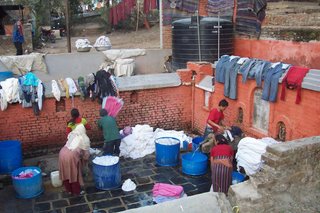
Christmas day turns out to fall on Kathmandu's laundry day.
Some of the most interesting places to visit are the Buddhist temples and Tibetan refugee villages which dot the entire Kathmandu valley. We visited the most important stupas, Swayambunath and Bodnath, where the monks allowed us to sit with them during their ceremonies. One of the monks begins with the low, ethereal, Tibetan chant. Over top of this barely audible rumble, an entire room full of at least 50 monks begin to chant, rhythmically and in unison, the syllables of a verse. Suddenly, a cymbal crashes, winds cry, and horns blast in an ear-splitting cacophony to break this contemplative rhythm. According to an Irish student of Buddhism I met later, the Tibetan verses simply describe a scene which the monks attempt to imagine in great detail as they repeat the verse over and over. The banging of the percussion and the harsh horn blasts are intended to represent the grand entrance of the Buddha, or one of his incarnations, into this scene.
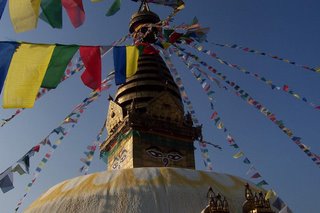
Tibetan Prayer flags fluttering over Swayambunath Stupa. The watchful eyes of Buddha gazing in all four direction over the Kathmandu valley. The nose-like sign below the eyes is the Nepali number one; it is a symbol of unity.
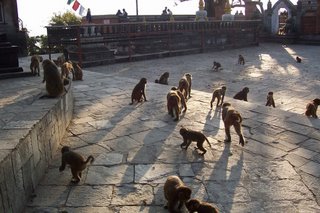
In Nepal, both Buddhists and Hindus have worshiped peacefully together at the same temples for years. Both Buddhist and Hindu shrines are juxtaposed in the same compound. Furthermore, Swayambunath stupa is over-run by monkeys who are considered sacred animals by Hindus. Thus, Swayambunath is affectionately known as "The Monkey Temple" by the locals.
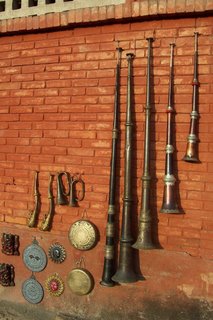
Tibetan horns and cymbals.
Nepal is the lesser known home to its legendary people: the birthplace of Buddha and refuge to many of his modern spiritual followers, the Sherpa people who are still paramount in the ascent and exploration of the world's highest mountains, and the fierce Gurkha warriors many of whom still serve as the Dalai Lama's personal guard and are employed by the British military. The traditions of these and Nepal's other people have remained intact over the years. Unlike India, Nepal was never significantly influenced by the British who decided early that the rugged hill side terrain would be too difficult to colonize. In fact, after initial conflicts with the west in the early 1800s, Nepal shut themselves off completely and the country was almost entirely unseen by foreigners until 1951.
The most important residents of the Kathmandu valley are the Newari. They are the inventors of the pagoda and therefore their architectural heritage, disproportionate to their fame, can be seen throughout Asia. Furthermore, the painfully spicy Newari meat dishes serve as a delicious caveat to the bland and soupy lentils otherwise dominating Nepali food. While reading an entertaining and informative book by a Nepali girl once worshiped as a living goddess, called From Godess to Mortal: The True Life Story of a Former Roayal Kumari by Rashmila Shakya, we became most interested in these people and visited their ancient and once-glorious cities at Patan and Bhaktapur.

Patan's Durbar square provides the largest density of Newari architecture in the world.
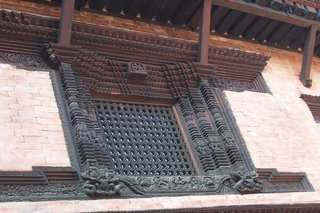
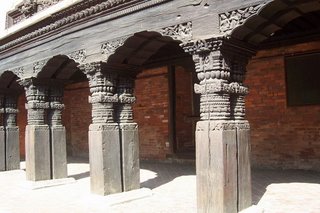
Examples of Newari architecture.
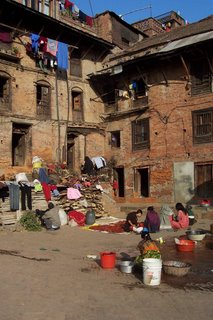
.Bhaktapur in graceful decay. At first glance, many of the old buildings appear dilapidated. Closer inspection reveals elegant Newari touches.
And what do you think the sport of choice is in Shangri-La ? Hacky-sac, of course. Children all over Nepal can almost always be seen enjoying a good hack. Too poor for our decadent western style cloth bags, children forge their makeshift hack-sacs out of a tangled ball of elastic bands rummaged from the garbage !
|



